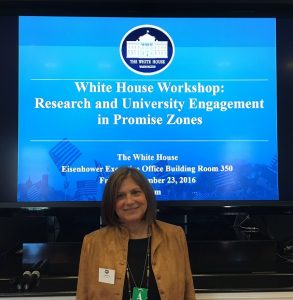May 31, 2017

Director Kevin Volpp, MD, PhD, and researchers Frances Barg, PhD, Carolyn Cannuscio, ScD, Amy Jordan, PhD, and Jason Karlawish, MD, discuss their approaches to health behavior change research in a video about research methods at the UPenn PRC.
Feb 8, 2017
 Observing that “lifesaving technologies have proliferated dramatically within the past few decades, yet there is scant understanding of the ramifications of such technologies in the world of patients and their families,” PRC Researcher Frances Barg, PhD, MEd, and co-authors examine how patients and their families face health decisions that accompany use of the LVAD (left ventricular assist device) heart pump in the January 2017 issue of The American Journal of Bioethics.
Observing that “lifesaving technologies have proliferated dramatically within the past few decades, yet there is scant understanding of the ramifications of such technologies in the world of patients and their families,” PRC Researcher Frances Barg, PhD, MEd, and co-authors examine how patients and their families face health decisions that accompany use of the LVAD (left ventricular assist device) heart pump in the January 2017 issue of The American Journal of Bioethics.
“The findings from our study sound the call for further investigation of nuanced approaches to patient-centered interventions that take into account the impact of technologies on meaning, identity, and patient and family experience,” according to the authors. “Such intervention may better prepare and orient patients and their families to life with the LVAD. It is incumbent upon those of us who work with these technologies to recognize the complexities of these experiences and reflect upon the emergent ethical, clinical, and social cultures that can obscure them.”
Oct 5, 2016

On September 23, 2016, PRC Principal Investigator, Fran Barg, PhD, and Co-Investigators Heather Klusaritz, PhD, Karen Glanz, PhD and Peter Cronholm, MD, for the Philadelphia Health Leadership Institute (PHLI) project traveled to Washington to participate in a White House Workshop on Research and University Engagement in Promise Zones.
In his 2013 State of the Union address, President Obama announced the establishment of the Promise Zones Initiative to partner with high-poverty communities across the country to create jobs, increase economic security, expand educational opportunities, increase access to quality, affordable housing, and improve public safety. Philadelphia was one of three cities to receive the first Promise Zone designations in 2014. Today, twenty-five communities have received a Promise Zone designation.
The White House workshop brought together leading researchers and academic institutions from Promise Zone communities to examine how university partnerships can support Promise Zone initiatives and advance the goals of the program.

Dr. Klusartiz lead the Access to Care working group and, with Drs. Barg and Glanz, participated in a discussion on best practices for academic-community partnerships and the challenges faced in building these partnerships. The PHLI was used as an example of the capacity building role universities bring to partnering with Promise Zone communities.
Klusaritz said “this event demonstrates the Federal government’s commitment to promoting and supporting Academic-Community partnerships. And the participants showed an equal commitment to addressing the concentration of health and social needs in their Promise Zone neighborhoods.” Noting the importance of the Promise Zone initiative and of the role of universities in working towards President Obama’s declaration that a “person’s zip code shouldn’t decide their destiny,” Klusaritz added “sharing time with other Promise Zone projects around the country brought home how our Penn PHLI project is uniquely positioned to build capacity to effect change in the Philadelphia Promise Zone.”
.


 Observing that “lifesaving technologies have proliferated dramatically within the past few decades, yet there is scant understanding of the ramifications of such technologies in the world of patients and their families,” PRC Researcher
Observing that “lifesaving technologies have proliferated dramatically within the past few decades, yet there is scant understanding of the ramifications of such technologies in the world of patients and their families,” PRC Researcher 

